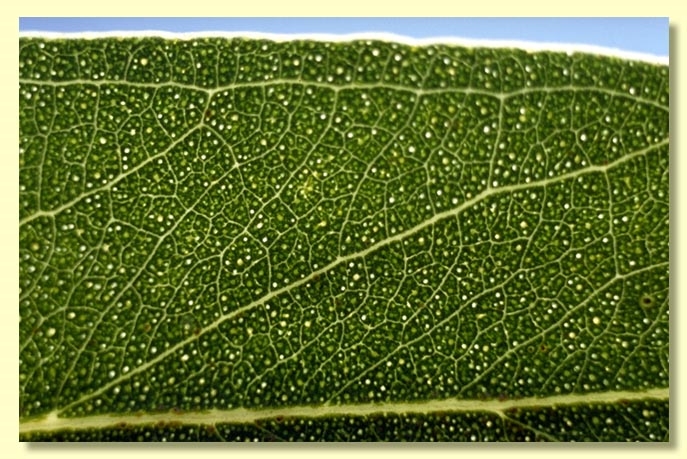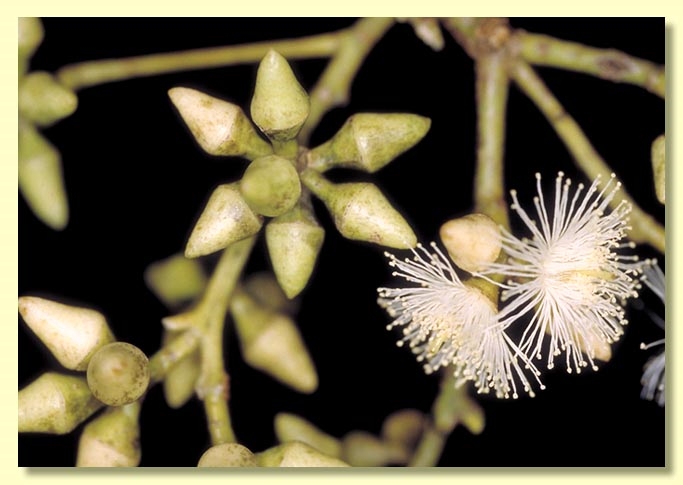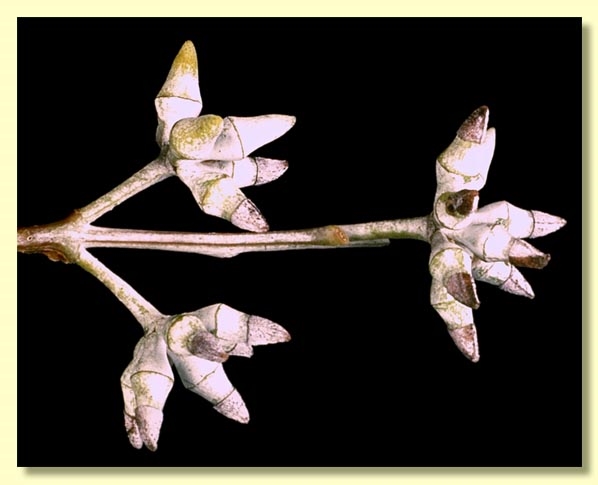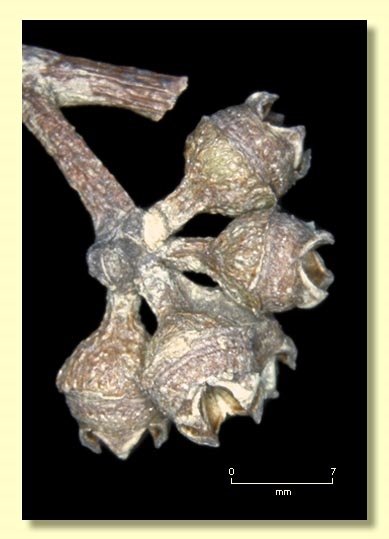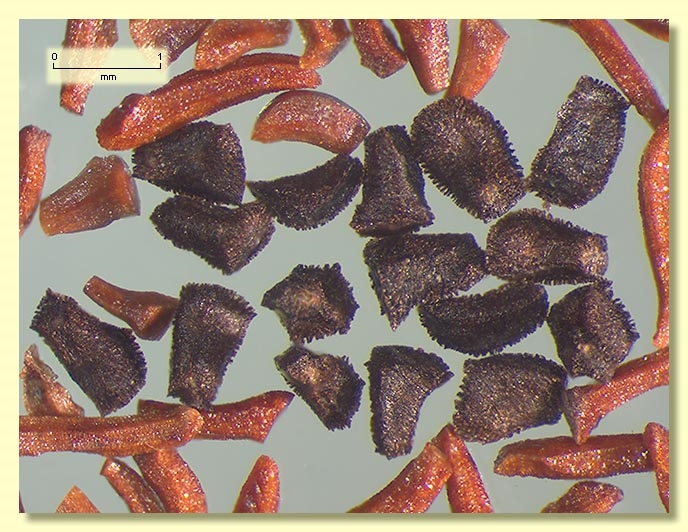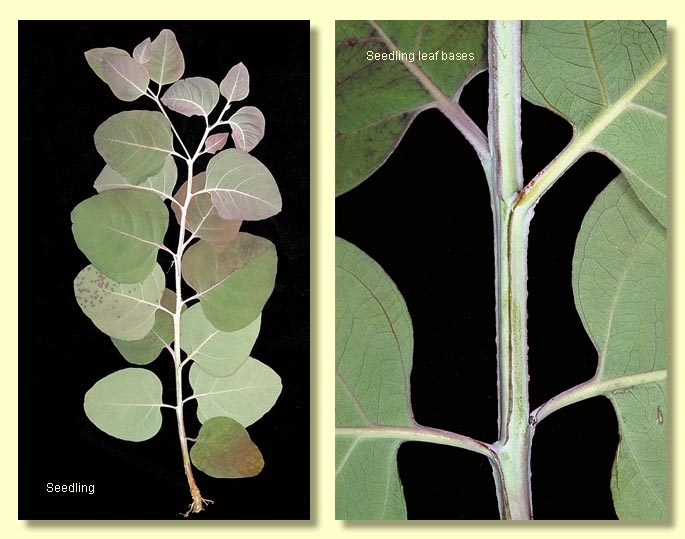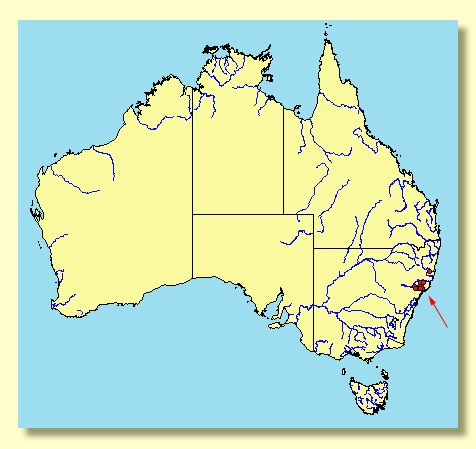Euclid - Online edition
Eucalyptus glaucina
Eucalyptus | Symphyomyrtus | Exsertaria | Erythroxylon
Eucalyptus umbellata var. glaucina Blakely, Key Eucalypts 130 (1934) p.p. as to type; E. tereticornis var. glaucina (Blakely) Cameron, Victorian Naturalist 63: 43 (1946). T: Williams R., NSW, Aug. 1906, J.L.Boorman s.n.; holo: NSW.
Bark smooth, white and grey with patches of pink, orange or green; sometimes becoming granular or powdery with age.
Juvenile growth (coppice or field seedlings to 50 cm): stem square in cross-section; juvenile leaves always petiolate, opposite for very few pairs then alternate, orbicular to ovate, 6–10 cm long, 5–6.5 cm wide, bases rounded to truncate, green to blue-green or glaucous.
Adult leaves alternate, petiole 1–2.8 cm long; blade lanceolate, 9–17 cm long, 2–4.2 cm wide, flat or undulate, base tapering to petiole, concolorous, dull, green to blue-green or glaucous, side-veins greater than 45° to midrib, moderately to densely reticulate, intramarginal vein parallel to and well removed from margin, oil glands mostly island.
Inflorescence axillary unbranched, peduncles 0.7–2 cm long, buds 7 per umbel, pedicellate (pedicels 0.3–0.7 cm long). Mature buds ovoid to oblong to diamond-shaped (0.9–1.4 cm long, 0.4–0.7 cm wide), usually glaucous at first, often maturing green to yellow or creamy, scar present, operculum conical to horn-shaped (0.5–1 cm long), stamens erect, anthers cuboid to oblong, versatile, dorsifixed, dehiscing by longitudinal slits (non-confluent), style long, stigma blunt or tapered, locules 3 to 5, the placentae each with 6 vertical ovule rows. Flowers white.
Fruit pedicellate (pedicels 0.3–0.5 cm long), hemispherical, 0.3–0.6 cm long, 0.6–1 cm wide, disc raised, convex, valves 3 to 5, strongly exserted.
Seeds usually black, 1–1.5 mm long, pyramidal or cuboid, dorsal surface usually pitted, hilum terminal.
Cultivated seedlings (measured at ca node 10): cotyledons reniform to oblong; stems square in cross-section, often winged also, glaucous; leaves always petiolate, opposite for 4 to 6 nodes then becoming alternate, orbicular to ovate, 6.5–10 cm long, 4.5–8 cm wide, base truncate to tapering, apex rounded to pointed, glaucous.
Flowering has been recorded in November.
A spreading small to medium-sized woodland red gum tree of low coastal ranges and tablelands of central-northern New South Wales, e.g. the Gresford and Gloucester areas, in largely cleared country, and also near Casino. A red gum of the black, toothed, single-coated seed group, E. glaucina is notably glaucous in the juvenile leaves, buds and fruit.
Eucalyptus glaucina belongs to the group of red gums which is distinguished by having buds with the stamens mostly erect, fruit where the disc is united to the ovary roof and by the black, toothed, cuboid to pyramidal single-coated seed. Fifteen species belong to this group: E. amplifolia, E. blakelyi, E. chloroclada, E. dealbata, E. dwyeri, E. flindersii, E. gillenii, E. glaucina, E. infera, E. kabiana, E. nandewarica, E. nudicaulis, E. tereticornis, E. terrica and E. vicina.
Within this group, E. glaucina is closest to E. tereticornis, a common forest tree east of the Dividing Range in eastern Australia from Bega to the top of Cape York Peninsula. It differs from E. tereticornis by the habit and the more robust, glaucous buds and fruit. Intergrades with E. tereticornis occur. E. glaucina is also close to E. amplifoila, which is not glaucous and has large glossy green juvenile leaves. The only other two members of this group with glaucous buds and fruit are E. dealbata, which is always glaucous and E. blakelyi, which is usually not glaucous but occasionally glaucous near the southern end of its distribution. E. glaucina differs from E. dealbata by having larger orbicular to ovate juvenile leaves, 5–6.5 cm wide in E. glaucina but ovate and usually narrower than 5 cm in E. dealbata. E. glaucina differs from both E. dealbata and E. blakelyi by having slightly larger more robust buds, with a longer operculum than both.
Within its area of occurrence, E. glaucina may also be confused with E. parramattensis, another smooth-barked red gum from the series Liberivalvae. E. glaucina can be distinguished by having fruit with an ascending disc that is fused to the remains of the ovary roof, unlike the annular disc of series Liberivalvae that is free from the remains of the ovary roof. Also E. parramattensis never has glaucous buds and fruit like E. glaucina.
Eucalyptus glaucina is listed as "Vulnerable" under the Australian Government Environment Protection and Biodiversity Conservation Act 1999 (EPBC Act). Further information may be found at this web address:
http://www.environment.gov.au/cgi-bin/sprat/public/sprat.pl



